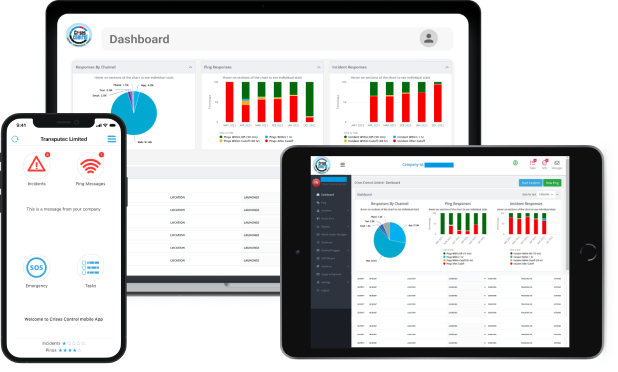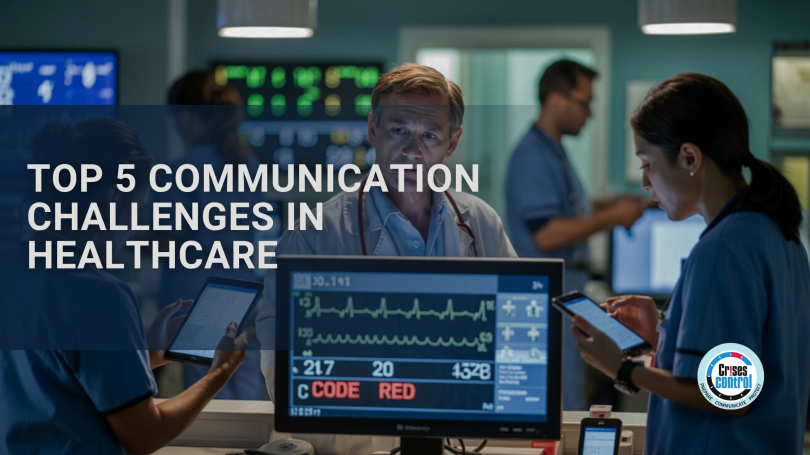Written by Asipe Nokenke | Marketing Assistant
In healthcare, every second counts. Effective communication during emergencies can significantly improve patient outcomes and save lives. The World Health Organization recognises the critical role that timely and accurate communication plays in managing health crises worldwide. However, despite advances in medical technology, many hospitals and healthcare networks still face major challenges in emergency communication.
From mass casualty incidents to cyber threats and critical equipment failures, healthcare emergencies require rapid, coordinated responses. Yet outdated systems and fragmented communication processes often slow down vital alerts and actions.
This is where Mass Notification Software, especially when built for healthcare, changes the game.
1. Slow, Fragmented Alerts Across Departments
In many hospitals, emergency alerts still rely on manual call trees, overhead paging, or departmental email lists. These methods are often too slow to mobilise staff in high-pressure situations, prone to errors when contact details are outdated, and inconsistent between departments, leading to uneven responses.
When a patient in the ICU needs urgent surgery or a chemical spill occurs in A&E, delays of even 60 seconds can put lives at risk and compromise patient outcomes.
Crises Control in Action:
- 24/7 Multi-Channel Alerting: Send alerts via SMS, voice, push notification, email, or secure Ping, ensuring staff on and off-site receive updates instantly.
- Pre-Built Incident Templates: Trigger predefined “Code” alerts like Code Blue (cardiac arrest) or Code Yellow (evacuation) to reach exactly the right people without manual distribution.
Real-World Scenario:
A large hospital group with multiple facilities, including emergency care, maternity, and surgical procedures, struggled with fragmented notification systems, causing delays during emergencies like Code Blue and Code Red. After implementing Crises Control’s automated alerts and audit-trail reporting, they streamlined emergency communication, improving response times and patient safety.
“Crises Control has been indispensable in our hospital’s emergency management. With the ability to send automated alerts and track every response, we are able to act faster and more effectively.” — Head of Emergency Services
2. Communication Breakdowns During IT or System Failures
Hospitals are increasingly dependent on digital infrastructure. When those systems go down, whether due to cyberattacks, ransomware incidents, or power outages, internal communication often collapses, staff may lose access to contact databases stored in the hospital information system (HIS), internal messaging such as email or intranet becomes unavailable, and confusion over backup communication protocols slows response efforts.
Crises Control in Action:
- Cloud-Based, Independent Platform: Operates even when core hospital IT is offline.
- Integration with HIS: Automatically syncs staff and departmental data for rapid access when needed.
- Automated Disaster Recovery Triggers: Detects outages and initiates response plans instantly, reducing manual intervention.
Real-World Scenario:
A healthcare provider in Abu Dhabi found traditional communication methods like email and manual call trees insufficient for urgent incident notifications. After adopting Crises Control, they grouped personnel into communication tiers and enabled instant alerts at the push of a button. This upgrade improved response speed and ensured critical information reached the right people without delay.
“Crises Control has provided us with the confidence and assurance that the right people are always notified during incidents, saving us valuable time and helping us focus on critical tasks.” — Readiness and Continuity Manager
3. Poor Coordination Across Multiple Teams and Sites
Major healthcare incidents rarely stay contained to one unit. They often require coordination between A&E, ICU, surgical teams, facilities management, and sometimes multiple sites. Without centralised communication, departments receive inconsistent instructions, tasks are duplicated or missed, and external agencies (ambulance, police, fire) may receive incomplete information.
Crises Control in Action:
- Structured Incident Management: Assigns tasks to the right roles with deadlines and progress tracking.
- Custom Workflows: Embed hospital-specific protocols, from mass casualty triage to infectious disease isolation procedures.
- Geo-Targeted Alerts: Send location-specific instructions to avoid unnecessary alarms across the entire network.
Real-World Scenario:
At the Royal Devon and Exeter NHS Foundation Trust (RD&E), managing multiple community and acute sites, coordination of out-of-hours critical care transfers was challenging. Crises Control enabled a voluntary transfer team to be activated from home via SMS, phone, and push notifications. The system tracked who received alerts, their responses, and arrival status, reducing delays and preventing staffing shortages.
“Crises Control helps us improve our team communication, response, and activation times.” — Dr James Garwood, Lead for Critical Care Department’s Out-of-Hours Inter-Hospital Transfer Team, RD&E
4. Failure to Monitor and Alert for Operational Risks
Not all healthcare emergencies start with patients. Equipment and environmental failures can have devastating knock-on effects, such as vaccine storage temperature deviations, HVAC malfunctions in operating theatres, or power failures in critical care units.
Crises Control in Action:
- IoT and Sensor Integration: Connects to temperature monitors, HVAC systems, and other sensors.
- Immediate Alerts on Breach: Sends instant notifications when thresholds are exceeded, allowing staff to act before damage occurs.
Real-World Scenario:
A hospital pharmacy integrated Crises Control with its refrigeration sensors. When temperature levels rose beyond the safe range for insulin storage, the pharmacy team received immediate alerts, preventing loss of valuable medication stock.
5. Compliance Gaps and Inconsistent Testing
Healthcare organisations must comply with stringent emergency preparedness standards, such as HIPAA in North America, GDPR in Europe, and national patient safety regulations. However, many hospitals struggle to run regular, realistic drills, fail to maintain complete audit trails, and have inconsistent readiness across multiple sites.
Crises Control in Action:
- Simulation Tools: Schedule and run drills without disrupting patient care.
- Full Audit Trails: Automatically record all actions taken during incidents.
- Regulatory Mapping: Aligns with standards like HIPAA, GDPR, Joint Commission, and national emergency frameworks.
How Crises Control Supports Healthcare Compliance Globally
| Region | Key Regulations | How Crises Control Helps |
| North America | HIPAA, Joint Commission standards, and FDA device communication rules | Encrypted messaging for PHI protection, compliance-ready notification logs, integration with clinical workflows |
| Europe | GDPR, EU Patient Safety Framework, and national emergency management laws | GDPR-compliant data handling, secure communications, and integration with hospital systems for incident documentation |
| Middle East | Local health authority disaster management rules, data protection laws | Configurable workflows for local protocols, multi-language support, and audit-ready reports |
Why Reliable Healthcare Emergency Communication Saves Lives
The healthcare sector is uniquely high stakes: teams must respond to emergencies that are unpredictable, time-critical, and often multi-faceted. Legacy systems like pagers or static call trees simply cannot deliver the speed, accuracy, and coordination required in modern healthcare environments.
A fit-for-purpose Mass Notification Software for Healthcare should be:
- Fast: Seconds, not minutes, to alert the right people.
- Reliable: Operational even during IT or power failures.
- Integrated: Seamlessly working with hospital systems and protocols.
- Compliant: Supporting the full range of healthcare regulations.
Conclusion: Control the Chaos Before It Reaches the Patient
Every second matters in healthcare emergencies. By eliminating slow alerts, bridging IT outage gaps, uniting multiple teams, monitoring operational risks, and closing compliance gaps, hospitals can protect patients, staff, and their own reputation.
Crises Control provides healthcare providers with a secure, integrated, and automated platform to meet these challenges head-on, whether the emergency is clinical, operational, or environmental.
Contact us today for a free demo and see how our Mass Notification Software can transform your healthcare emergency communication before the next incident tests your readiness.
Request a FREE Demo

